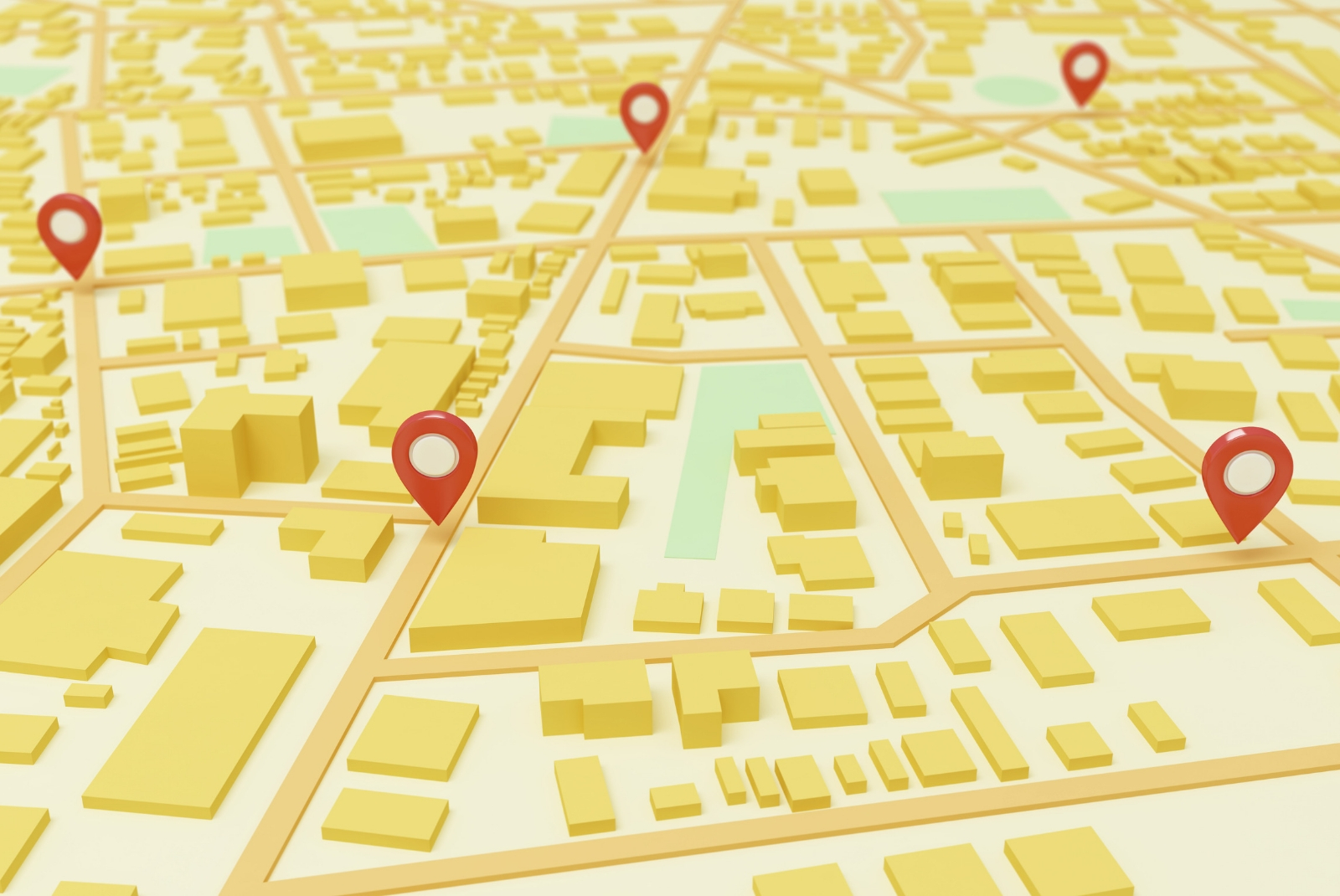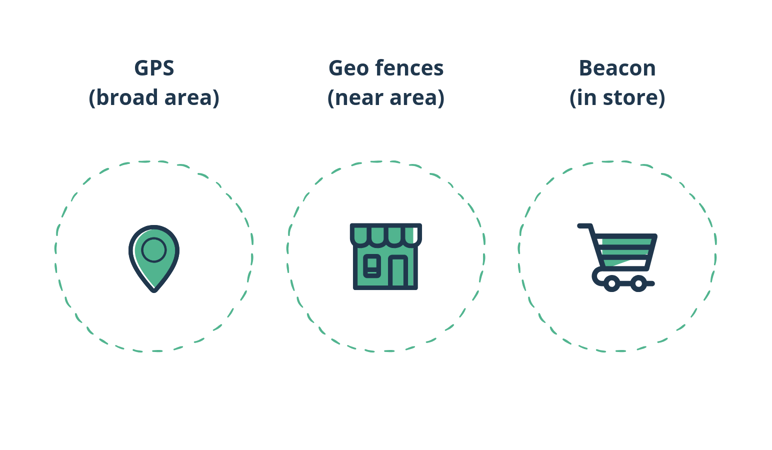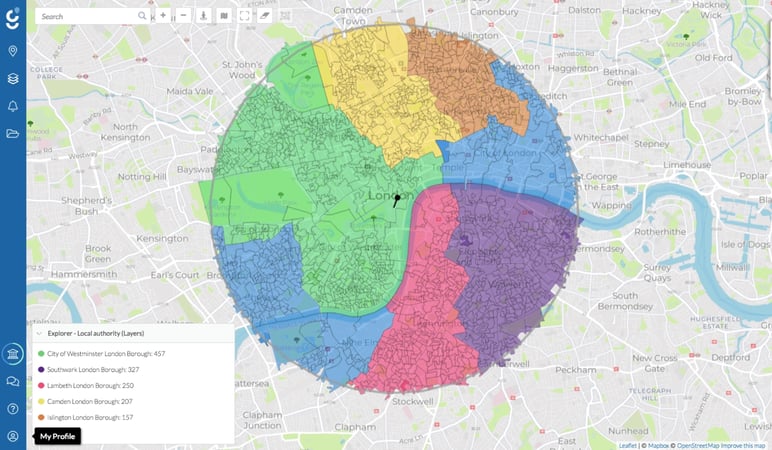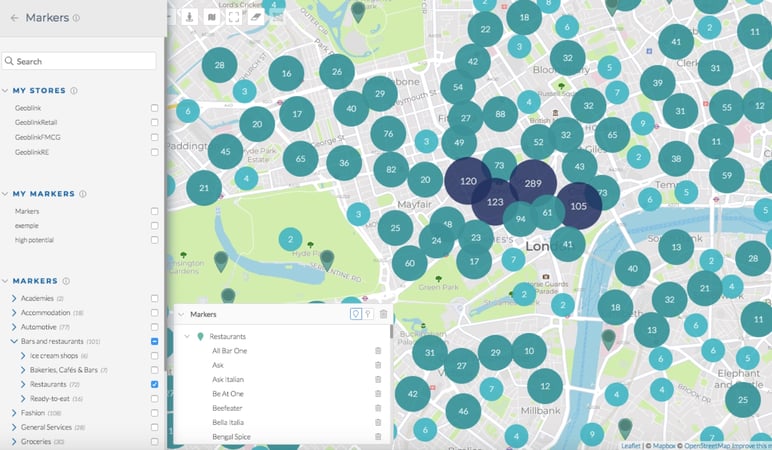
The problem with technologies that have made harvesting location data possible is the same one that arises in a detective thriller.
Take an average George for example — he wants to know everything about his favourite tea brand, like where he can find the specific Ceylon tea he is looking for, how many boxes they have left on the shelves, or if there is stock in a shop near the hotel he is staying over the weekend. But the other way around is a very different story for George.
Does he want the tea brand to know about his movements? Is he comfortable with the company knowing that he is in a different town this weekend and that they tailor their Google ads to that location?
Consumer privacy always comes first, but it’s curious to see how technology advancements represent an advantage and a disadvantage for users and businesses at the same time, and how hard it is to unravel good practices from the dishonest ones.
The use of data location for online positioning and tailored searching and shopping experiences is still the subject of a lot of debate. The possibilities of offering better suggestions and product information to consumers gets muddled up with the perils of invading the users’ privacy by knowing where they live or where they are at the moment.
Could we live in a world where George is guaranteed a customized shopping experience that does not compromise his privacy? Let’s see the latest trends about geomarketing and location intelligence.
Table of contents
- Dial G for Geomarketing: What is location intelligence?
- North by Northwest: Data origin and how to target with geomarketing
- The Brand Who Knew Too Much: The implications of using location data
- Rear Shop Window: How e-commerce sites benefit from geomarketing
Dial G for Geomarketing: What is location intelligence?
First things first, geomarketing is a way of tailoring online contents or campaign ads according to a specific geographical region or territory. That means that every person (or IP address) that makes an online search or opens a website within a specific radius will see some ads, products or online design different from the ones that could see another user in the opposite part of the world (or maybe just the next town).
This is the basic approach, an application of data location for plain advertising purposes.
Location intelligence can offer further uses and valuable information for marketing teams and businesses, specially when Google’s, Facebook’s and other online algorithms are not ensuring results as precise and successful as it would be expected.
The burden of new disciplines can overwhelm companies, as more than 20 billion devices will be somehow connected and gathering data by 2021. How do you handle such amount of information and how any business can create a winning user experience if the networks keeps constantly growing? It’s a quantity problem (how and where to store or have access to that data), and also a quality problem (what type of software, technologies and professionals can understand this new data).
According to this report, ensuring data quality and accuracy (49%), gathering data in real time (40%), and extracting data from existing systems in a usable way (39%) are the most commonplace challenges in terms of data collection for businesses that use location intelligence. But a third of companies don’t have the personnel or technologies necessary to achieve these goals, and 42% still don’t use a location intelligence platform.
Location intelligence involves all the practices applied to gather location data and to transform it into useful information for businesses: competitive analysis, content improvement, and error detections.
This type of software and teamwork are rising in importance for businesses. They go beyond pinpointing on a map where each order comes from in real time (a type of tech that we can’t use yet, despite what movies like The Intern want you to believe). But lack of proper training and ever changing regulation make it difficult to properly see all the alternatives offered by geolocation technologies.
Also, a significant problem related to geotargeting is the lack of precision and accuracy of the location data. Not only some person’s location might be some miles away from the spotted geoposition, as lots of things can interfere with their devices and GPS signals, but there are lots of users ‘hiding’ behind IP location blockers that give unreliable information about their real location.
“Retailers are becoming increasingly more aware of the fact that location does impact the performance of their businesses—now more than ever. In fact, all of the pressure out there on the high street is actually working in raising the profile of Location Intelligence technology amongst retailers as they gravitate towards developing more data-driven strategies to power their retail networks.” | Julien Hennico, Geoblink VP of Marketing
Types of geographic information systems
Geolocation technologies keep evolving and you can find lots of systems for gathering, managing and analyzing geospatial data, also known as geographic information systems, GIS or GIScience.
Mapping interactive interfaces and wireless devices are the most popular ones at the moment, but new and more sophisticated solutions will surprise us in the near future as they incorporate aerial photography and satellite connections for more precise information.
These are the geotargeting solutions most used by businesses for their online and offline strategies:
GPS
GPS is most basic system available for geotargeting purposes. It allows tracking user through a global navigation satellite system and determine their location coordinates. It’s used a lot, as people can locate stores, products or deliveries in their mobile maps in real time. Business can also combine this information with other demographic information in order to keep in touch with users within a specific area (neighborhood, ZIP code, city…).
Experts state that mobile data will be the next big thing for location intelligence, as GPS transform every smartphone into a little, portable, wireless and super efficient geolocator.
Beacons
Real-time locating systems are one of the first geolocation technologies adapted for stores, and probably the cheaper option available.
Beacons (or BLEs, Bluetooth Low Energy systems) are little electronic devices installed inside a brick-and-mortar shop. If customers have an official beacon-platform app in their mobile phones and they enter a beacon-enabled store, they will receive tailored alerts and promos while they look around the store.
They only work in specific places and don’t identify what type of user is inside the store, only that someone is in it. Large store chains like Target and Woolworths are already using this technology to engage with people in store.
Although some studies point out that 76% of retailers use beacon for analytic purposes, and only 39% are using them for geolocated advertising. They have proved to be a huge first step for businesses towards the possible applications of data location.
Geo-fencing
This strategy most commonly involves GPS technology and defines a perimeter within 50 meters around brick-and-mortar shops. This allows businesses to geotarget ads for people that walk by and that could be attracted via SMS, push notifications, e-mail, or even social media alerts.
Geo-fencing is especially used when stores have a fierce competition around them and are looking for an extra effort to gain occasional customers. Geo-fences are demonstrating to improve click-through rates and app open sessions per day.

Data mining: Social media & geomarketing
There are some theories and guidelines that are beginning to address the importance of data location for social media, like Vigilant Marketing Intelligence, as proposed by The Harvard Business Review, which combines geolocation with social media data.
This approach integrates the information of a social media post and the location from which it was posted. Vigilant marketing involves carefully monitoring the customer’s journey to better understand how they reach a product or channel, or if the after-shopping experience maintains optimal satisfaction levels. But what makes brands vigilantes… or stalkers?
Some industries use these technologies and practices for the user’s benefit, like checking for adverse reaction to medicines, following up therapy treatments, or analyzing the security of an autonomous car. Other types of business might not seem to have such a disinterested purpose, but they could use location-based social media data to reduce churn rates, easily detect incidents, and improve the overall user experience.
Nevertheless, it’s important to develop a strong system that is able to detect located behavior patterns and develop the right reactions to customers’ needs in a specific location, like a long queue in the coffee shop, or a theme park ride that is experiencing some technical problems.
Mobile advertising is arising as a bigger investment for location-based marketing campaigns, and it will reach over $38 billion by 2022, according to a BIA/Kelsey’s survey, especially through personalized social media videos on Instagram, YouTube and other such platforms.
“Geomarketing is a highly sophisticated tactic that can be used to launch dynamic marketing campaigns aimed at distinct consumer segments. However, to be able to launch geomarketing campaigns effectively, the retailer needs to first understand which consumer profiles surround each and every one of their points of sale in order to target them correctly.” | Julien Hennico, Geoblink VP of Marketing
North by Northwest: Data origin and how to target with geomarketing
It’s probably no coincidence that diverse professional groups as manufacturing, retail, marketing, sales, research, and development placed location intelligence as one of the most important disciplines to bear in mind since 2017. That interest is not going to fade away in the next years, as technologies keep improving and offering uses hitherto unknown.
Government, real estate, transportation, and telecommunications industries were the main users of location intelligence until now. But now software systems are becoming affordable to other types of companies and new regulations are permitting the application of data location for commercial purposes. Retail, banking, insurance, and finance are some of the industries most interested in location intelligence, along with companies that base their business on customers geodata, like lift services as Uber.

Studies indicate that the top location intelligence applications for businesses from several industries are data visualization and mapping, geomarketing, territory management, and site planning. These are more visual and efficient ways to display insights about business geographical strategies, audiences, and sales trends, and help companies better understand what resources need reinforcement and where to focus their efforts.
As the favourite possibilities and features offered by location intelligence systems we can find:
- Drill down navigation
- Choropleths (shading maps to show values or themes)
- Customization by regions
- Syndication by demographics
- Distance calculations
- Integration with third parties location analytics (Google, Oracle, ESRI…)
- Cloud based systems over on-premise
- Data displayed with symbols or animations
- Support for interior spaces and stores
- Offline mapping
To Catch a Customer: Examples of geomarketing applications
Media diffusion campaigns
Geolocation can help marketing teams while designing their campaign strategies, as location intelligence provides valuable data about where there are more potential customers and how to tailor ads and messages by demographics. This helps businesses launching street marketing campaigns down to the postal code level, billboard campaigns in specific city locations, and prevent wasteful spending.
There’s also a very widespread use of location intelligence for attribution analysis, which sheds light on in which regions, cities or countries a campaign or promotion will be most effective. This can come in handy for brands that sell internationally and need to predict where are their most demanding foreign customers and how they should build a marketing global campaign.
Business expansion
As mentioned above, location data allows businesses to identify where are their customers and therefore what is the most secure way to expand its network. It’s obvious that if a company identifies that most of their online searches come from Australia it could be an interesting option to expand their business to that market.
If it is properly gathered and analyzed, location intelligence leads to better understanding of the behavioral data too — why people buy or behave in a specific way in one location, what they buy, how often, in what quantity, at what time?
Businesses should study patterns by neighborhood, city area by income, usual passers-by according to public transport routes, and average online spending per user in one area to see how things stand before opening new brick-and-mortar stores or online channels.
“Location Intelligence can really become a marketer’s secret weapon because it allows them to deep dive into the unique market conditions around each store.” Julien Hennico, VP of Marketing at Geoblink
Responding to customers needs
By profiling types of customers by location, a company’s customer service operations can quickly predict and address any problem and query. Location data shows what type of problems are repetitive or more often among certain users, online channels or areas, and it helps businesses to improve response time, the relationship with the audience, and customer loyalty.
Valuable data not only helps companies to expand their strategies, but to improve their foundations and detect sources of frustration that were hard to pinpoint before these technologies even existed. For example, location data can show how many delivery incidents happen in a certain area that has very poor connections or pick-up store alternatives, so the company should evaluate other solutions for those customers.
As Julien Hennico from Geoblink states, by pinpointing the locations where there are high concentrations of customers who order products online, the retailer can set up different points of return which will make it easier for customers to send back the items that don’t fit them. Relieving this pain point through geolocated data is definitely a way to boost customer loyalty.
But it is useful for broadening positive circumstances too, like segmenting an omnichannel strategy on what type of customers come more often to a store, what routes they follow, or which items they return more frequently.
Competence analysis
Businesses share the Internet and the streets — location intelligence gives information about customers… but moreso, about their competition.
The presence of competitors’ points of sale can be compared in the areas and countries where any other business plans to open some stores or begin a segmented ad campaign. At this point, the strategy is not only about where to catch new customers, but where to spot places that nobody has taken before, or how to avoid crowded areas where competition could be too fierce.
A company can also study their competition location data in order to stand up to them and trying to offer a better alternative to their usual customers — that depends on each business plan.
Improvement of delivery routes
Delivery times are a real problem for businesses that sell online or offer home deliveries, but the elephant in the room is why delivery staff can’t be faster.
The working conditions for many delivery employees are invariably bad. Planning an efficient route across the city or to reach a remote area is too difficult when everything is done on-the-fly.
Location data can help solve this problem if a company uses it to analyze where most orders come from, and how to design delivery routes that save precious minutes and cover a larger amount of area at the same time.
“Geolocation can be used to maximise the ROI of campaigns whilst also staying within a marketing budget. Knowing where customers live and plugging that information into the campaign planning process can really make all of the difference. Having this geolocated information is really a win-win as it helps marketers get the best results while only advertising to relevant audiences.” | Julien Hennico, Geoblink VP of Marketing
The Brand Who Knew Too Much: The implications of using location data
Everything is fun and games for location intelligence until a big problem arises: privacy. Remember how angry George felt when he realized his favourite tea brand knew where he was staying for the weekend?
Users’ privacy is a burning issue that makes companies follow the rules to the letter. Gathering information about people’s location and keeping that data for commercial purposes put companies on a knife-edge.
Using any data location technology is totally fine if businesses can ensure that all collected data is well-secured and users can access, modify and delete it at any moment. The recent scandals around Facebook prove how little some giant companies are doing for protecting users’ rights, and how carefully new technologies must be implemented.
That’s why developing a complete privacy policy is the first step before implementing a location intelligence software system — a public code that declares what type of data is being collected from users and for what purposes. All geo data must be anonymised and never used to track one particular customer.
European countries can follow their own official GDPR guidelines, which protect users by guaranteeing them the power to access, restrict, correct, and transfer data from any company. Users often don’t stop to think about how many information they are giving away on social media, but that shouldn’t be used against them. Good practices that protect customers’ data must be reached in order to ensure a correct application of a new technology.
Rear Shop Window: How e-commerce sites benefit from geomarketing
Offline visits
Although online sales are becoming the first source of profit for most businesses, a lot of shopping processes still begin in brick and mortar stores, as customers first check the products in person, or know the brand from previous purchases and visits.
That means that a business can learn a lot by keeping track of how many visits and sales are taking place in physical stores, how many of them are online orders pick-ups, and how many derivate in home-deliveries. Watching out how the customer journey works for a specific brand and how is the level of satisfaction in each store visit gives valuable data about the transition between offline and online shopping. Specific software that tracks online reviews and mentions across the Internet leverage the potential of geodata.
Geomarketing is also a powerful tool for identifying users that find themselves in new places and are looking for specific type of businesses. The ones that are more familiar to them will be the instant winners, and customers that find misleading or incorrect location data about stores will not buy from those businesses again.
Local SEO
Google can help any business find their local audience, but they must do their homework first.
Marketing teams should work on a local SEO strategy that includes keywords tailored by region, and that gives search engines updated data about business addresses, opening hours, and other useful details in those micro-moments when customers look for something near a specific location.
This also applies to local ads and social media, like promoting events that fit customers from the area that could become regulars.
The last time I was at an Anthropologie store, the lady at the counter did not ask me for my email address first, but if I lived in the area.
That way stores and brands aren’t just accumulating useless e-mail addresses, and they can associate geodata to their customers to send personalized mailings, promos, invites and ads.
Localized websites
Localizing a website can become a controversial matter for many businesses, besides being a task that needs a huge investment. But it’s no doubt that localized websites work better for users, even if the differentiation is just based on selecting a country and language (perhaps also currency).
More sophisticated website strategies use IP addresses to show users a homepage customized according to their geographical position (and this is a super useful strategy for mobile promos, as we will see next). But take into account that automatic localized websites can cause problems for users that prefer to choose the region and language manually, or that use some geolocation blockers.
→ Want to see an example? How Wrangler sells jeans with localized websites

Geo tagging
Adding metadata to content is an essential and often disregarded step for marketing optimization, and geo tags are already a new element. All type of content can have an associated geo tag, like images, blog posts or albums on social media platforms. These tags allow users identify where they can find a store that offers those products, or if the brand sells in their region.
Local interests
The local consumer is a specific type of client, and as happens with demographics they need tailored contents.
Contents adapted to local interests can attract customers near a business, or people that live in a geographical market of interest, and avoid lots of likes from India, where you don’t even ship orders to.
Geomarketing also gives businesses the opportunity to reach for audiences in small places like airports, stations, stadiums, malls or college campuses, tailoring the content to what will be of most interest to people in those places. And it also works in the short term, like customizing content and ads in locations during a brief period of time, like a pet show competition in a park, or a 3-day industrial trade show in the city.
Temporary promos
As we have pointed out when talking about beacon technology, geomarketing is being used nowadays mostly to place customized ads. Businesses with brick and mortar stores can offer daily deals, promo codes and other offers in one area or after a person enters a shop. It’s a common strategy to encourage regular visits, catch passerby people, and get customers from near competitors.
For example, McDonald’s is a pioneer in the application of beacon technology and geolocated ads, as in its official app users can find different daily offers depending on the location. And it’s a phenomenal way to study demographic behavior and developing campaigns with better conversions. What will drive millennials around Manchester more, a promo code for chicken nuggets or extra chips? Which of these offers result in more expensive orders according to the demographic, the time of the day or the neighborhood?
Conclusion
Despite the seriousness of the privacy issue, no company should be afraid of trying the immense possibilities offered by location intelligence technologies. Location data is another step into developing better strategies that comprehend markets, audiences, and the company’s own products or services.
Location intelligence can help businesses better understand what is missing in the customer journey both in online channels and brick-and-mortar stores. This impacts on how the user experience can be improved, how to create segmented geomarketing strategies. Learning when and how to address that micromoment gives customers a totally personalized service while respecting their private data.










